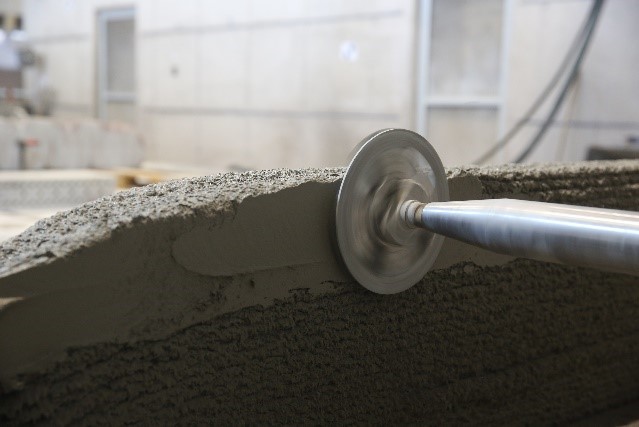Research Summary Report of A04
Integrated Additive Manufacturing Processes for Reinforced Shotcrete 3D Printing (SC3DP) Elements with Precise Surface Quality
[23.02.2024]
Dörrie, Robin
Phd candidate
Technische Universität Braunschweig
ITE Institut für Tragwerksentwurf
Main Goal
The project aims to fundamentally understand SC3DP technology to manufacture sustainable, multi-objective optimised, reinforced concrete components with precise surface quality and improved building physics via functional integration. It seeks to minimise carbon footprint by exploring varied material strategies, such as reducing cement content and design methods to decrease overall concrete volume. Additionally, it focuses on establishing reliable material and process control, emphasising fresh material laws for printability and durability, real-time monitoring of concrete properties, and component build-up strategies. Integration of large-scale reinforcement enhances structural suitability, while precise surface finishing ensures quality.
Summary
After finishing the final Demonstrator of FP1 new research questions arose, fundamentally informing the content of the FP2 proposal. A04 will focus on sustainability and advancing the SC3DP process to large scale applications. Therefore, initial steps like finding dedicated application cases for the material efficient manufacturing with SC3DP and systematic research on construction workflows will be taken in the first year of the second phase. At the same time, a new digital workflow for the optimisation of construction elements will be developed. Different optimisation strategies will be applied and adjusted to the process limitations.
Furthermore, different printing strategies have to be established for novel application cases. A combination of grading materials and elaborate nozzle designs will be the basis for these strategies. Consequently, rib structures, self-stiffening paths, force-flow oriented printing or temporary supports will be investigated. First experiments are planned to reveal the efficiency of these strategies. Together with B04 the accuracy will be surveyed in particular. Furthermore, the online adjustment of printing parameters will be tested on these printing strategies to increase the adjustability to complex geometries.
Current state of research
A04 has been working on understanding the influence of various parameter settings of the SC3DP process and on developing a model to understand the influence and correlation between different process parameters. Therefore, parameter studies were conducted and analysed, revealing the geometric opportunities of the process. In total 45 specimens have been printed to cover a range of parameters. The analysis was carried out in cooperation with B04 by scanning the specimens and analysing them.
Additionally, studies regarding the surface finishing of 3D printed specimens were conducted. The surface of 3D printed elements can be finished parallel to the printing process as well as after the process. These methods were evaluated in a large test series measuring different tools and parameter settings. Fig. 2 shows the post processing of a SC3DP wall element using a rotating trowel disc.











